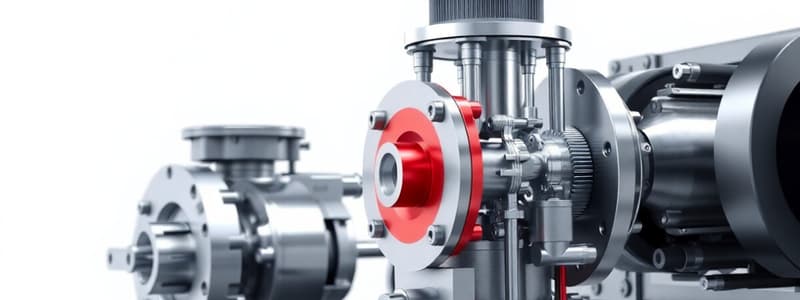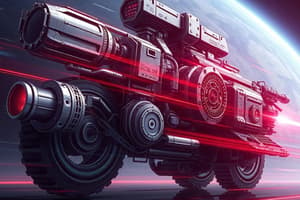Podcast
Questions and Answers
What is primarily used to ensure a machine performs functions with maximum economy and efficiency?
What is primarily used to ensure a machine performs functions with maximum economy and efficiency?
- Artistic design
- Scientific principles (correct)
- Imagination
- Market analysis
Which engineering principles contribute to the machine design process?
Which engineering principles contribute to the machine design process?
- Physics and thermodynamics (correct)
- Psychology and sociology
- Arts and humanities
- History and geography
What is a crucial part of creating a unique machine design?
What is a crucial part of creating a unique machine design?
- Avoiding technical specifications
- Following established templates
- Combining basic elements creatively (correct)
- Using only standard components
What is included in the final outcome of the machine design process?
What is included in the final outcome of the machine design process?
Which of the following is NOT a basic element of a machine?
Which of the following is NOT a basic element of a machine?
Which principle is foundational in understanding motion within machine design?
Which principle is foundational in understanding motion within machine design?
What primarily drives the need for a specific machine design?
What primarily drives the need for a specific machine design?
What role does imagination play in machine design?
What role does imagination play in machine design?
What is the primary objective of designing a machine element?
What is the primary objective of designing a machine element?
Which of the following best defines reliability in the context of machine parts?
Which of the following best defines reliability in the context of machine parts?
What does 'maintainability' refer to in the context of machine parts?
What does 'maintainability' refer to in the context of machine parts?
How does wear affect machine parts?
How does wear affect machine parts?
Which characteristic is essential for a machine part to avoid failure under load?
Which characteristic is essential for a machine part to avoid failure under load?
What is indicated by 'life-cycle cost' in machine parts?
What is indicated by 'life-cycle cost' in machine parts?
What principle should a designer apply when general-purpose machine elements are used under worst possible conditions?
What principle should a designer apply when general-purpose machine elements are used under worst possible conditions?
Why is rigidity important for a machine component?
Why is rigidity important for a machine component?
What is the primary function of a bearing in machine elements?
What is the primary function of a bearing in machine elements?
Which material is preferred for manufacturing complex machine parts such as flywheels and gearbox housings?
Which material is preferred for manufacturing complex machine parts such as flywheels and gearbox housings?
What aspect is NOT a consideration when selecting material for a machine element?
What aspect is NOT a consideration when selecting material for a machine element?
Which machine element is specifically used to transmit torque?
Which machine element is specifically used to transmit torque?
Why are transmission shafts commonly made of plain carbon steels?
Why are transmission shafts commonly made of plain carbon steels?
What is the function of a spring in a spring balance?
What is the function of a spring in a spring balance?
Which factor significantly influences the machinability of free cutting steels?
Which factor significantly influences the machinability of free cutting steels?
What is the purpose of a power screw in machine design?
What is the purpose of a power screw in machine design?
What academic degrees does V B Bhandari hold?
What academic degrees does V B Bhandari hold?
Which of the following is a topic covered in the book's introduction?
Which of the following is a topic covered in the book's introduction?
What is one procedure mentioned in the basic procedure of machine design?
What is one procedure mentioned in the basic procedure of machine design?
Which organization is V B Bhandari NOT a fellow of?
Which organization is V B Bhandari NOT a fellow of?
What aspect does 'Aesthetic Considerations in Design' focus on?
What aspect does 'Aesthetic Considerations in Design' focus on?
How many technical papers has Professor Bhandari presented and published?
How many technical papers has Professor Bhandari presented and published?
What is the role of 'Use of Standards in Design'?
What is the role of 'Use of Standards in Design'?
Which of the following is NOT a focus area of the design mentioned in the introduction?
Which of the following is NOT a focus area of the design mentioned in the introduction?
What is the purpose of a flywheel in a mechanical system?
What is the purpose of a flywheel in a mechanical system?
Which equation is typically used to describe the stress distribution in thick cylinders?
Which equation is typically used to describe the stress distribution in thick cylinders?
What design consideration is most directly related to the reliability of a machine?
What design consideration is most directly related to the reliability of a machine?
What is a key characteristic of a rimmed flywheel compared to a solid disk flywheel?
What is a key characteristic of a rimmed flywheel compared to a solid disk flywheel?
What effect does autofrettage have on pressure vessels?
What effect does autofrettage have on pressure vessels?
What is the primary focus of the section on 'Backlash' in spur gears?
What is the primary focus of the section on 'Backlash' in spur gears?
Which method is commonly used to analyze the strength of gear teeth?
Which method is commonly used to analyze the strength of gear teeth?
What is the purpose of estimating module based on wear strength?
What is the purpose of estimating module based on wear strength?
In the context of gear applications, what does 'effective load on gear tooth' refer to?
In the context of gear applications, what does 'effective load on gear tooth' refer to?
When considering the performance of helical gears, what aspect is crucial for their efficiency?
When considering the performance of helical gears, what aspect is crucial for their efficiency?
Which type of gear failure is typically considered when analyzing the performance of a gear system?
Which type of gear failure is typically considered when analyzing the performance of a gear system?
What does the terminology 'virtual number of teeth' in helical gears refer to?
What does the terminology 'virtual number of teeth' in helical gears refer to?
Which aspect is addressed in the section on 'Gear Lubrication'?
Which aspect is addressed in the section on 'Gear Lubrication'?
Flashcards
Machine Design
Machine Design
Using scientific principles, technical knowledge, and imagination to create a machine or mechanical system that performs specific functions efficiently and economically.
Engineering Sciences
Engineering Sciences
Principles like physics, mathematics, and thermodynamics that are used when designing machines.
Basic Machine Elements
Basic Machine Elements
Individual components like gears, bearings, and shafts that form a machine.
Machine Configuration
Machine Configuration
Signup and view all the flashcards
Design Process Outcome
Design Process Outcome
Signup and view all the flashcards
Customer Need
Customer Need
Signup and view all the flashcards
Maximum Economy and Efficiency
Maximum Economy and Efficiency
Signup and view all the flashcards
Technical Information
Technical Information
Signup and view all the flashcards
Strength of a Machine Part
Strength of a Machine Part
Signup and view all the flashcards
Rigidity of a Machine Component
Rigidity of a Machine Component
Signup and view all the flashcards
Wear Resistance
Wear Resistance
Signup and view all the flashcards
Reliability in a Machine Part
Reliability in a Machine Part
Signup and view all the flashcards
Maintainability of a Machine Part
Maintainability of a Machine Part
Signup and view all the flashcards
Life-Cycle Cost
Life-Cycle Cost
Signup and view all the flashcards
Fail-Safe Machine Design
Fail-Safe Machine Design
Signup and view all the flashcards
Machine Part Standards
Machine Part Standards
Signup and view all the flashcards
Machine Element Functions
Machine Element Functions
Signup and view all the flashcards
Force on Machine Parts
Force on Machine Parts
Signup and view all the flashcards
Why Choose Specific Material?
Why Choose Specific Material?
Signup and view all the flashcards
Cast Iron for Complex Shapes
Cast Iron for Complex Shapes
Signup and view all the flashcards
Steel for Shafts
Steel for Shafts
Signup and view all the flashcards
Low Carbon Steel for Automotive Parts
Low Carbon Steel for Automotive Parts
Signup and view all the flashcards
Free Cutting Steel - Easy Machining
Free Cutting Steel - Easy Machining
Signup and view all the flashcards
Why Experience Matters
Why Experience Matters
Signup and view all the flashcards
Design Synthesis
Design Synthesis
Signup and view all the flashcards
Selection of Preferred Sizes
Selection of Preferred Sizes
Signup and view all the flashcards
Aesthetic Considerations
Aesthetic Considerations
Signup and view all the flashcards
Ergonomic Considerations
Ergonomic Considerations
Signup and view all the flashcards
Concurrent Engineering
Concurrent Engineering
Signup and view all the flashcards
Spur Gears
Spur Gears
Signup and view all the flashcards
Law of Gearing
Law of Gearing
Signup and view all the flashcards
Backlash
Backlash
Signup and view all the flashcards
Beam Strength
Beam Strength
Signup and view all the flashcards
Wear Strength
Wear Strength
Signup and view all the flashcards
Module (Gear)
Module (Gear)
Signup and view all the flashcards
Internal Gears
Internal Gears
Signup and view all the flashcards
Gear Lubrication
Gear Lubrication
Signup and view all the flashcards
Flywheel
Flywheel
Signup and view all the flashcards
Coefficient of Fluctuation of Energy
Coefficient of Fluctuation of Energy
Signup and view all the flashcards
Solid Disk Flywheel
Solid Disk Flywheel
Signup and view all the flashcards
Rimmed Flywheel
Rimmed Flywheel
Signup and view all the flashcards
Stresses in Rimmed Flywheel
Stresses in Rimmed Flywheel
Signup and view all the flashcards
Study Notes
Machine Design Fundamentals
- Machine design utilizes scientific principles, technical knowledge, and imagination to create mechanical systems.
- Key elements of machine design include the application of physical principles like Newton's laws, fluid mechanics, and thermodynamics.
- Designers use technical knowledge of basic machine elements, such as fasteners, bearings, gears, springs, and shafts. These are combined to form a unique configuration for each specific machine.
- This process aims at maximum efficiency and economy.
- Design specifications must be clear and precise with clear functional statements.
- Designing a machine element involves considerations like strength, rigidity, wear resistance, reliability, maintainability, and life-cycle cost.
- Designers need to account for worst-case scenarios, employing fail-safe and redundancy principles.
- Machine parts should conform to standards.
- Consideration of the force (concentrated vs distributed) on the part is crucial.
Basic Procedure of Machine Design
- Design starts with specifying the function of the machine element.
- Example functions: supporting rotating shafts, transmitting torque, storing and releasing energy, measuring force, fastening parts, and creating uniform motion.
Basic Requirements of Machine Elements
- Strength: Components must withstand forces preventing fracture or yielding.
- Rigidity: Components must resist excessive deflection or bending. This is important for transmission shafts.
- Wear Resistance: Minimizing wear is critical to extend the useful life and maintain accuracy of machine components.
Material Selection
- Factors in selecting materials include availability, cost, mechanical properties, and manufacturing considerations.
- Material choices depend on the specific machine element and its function (e.g., cast iron for complex shapes, steels for shafts).
Studying That Suits You
Use AI to generate personalized quizzes and flashcards to suit your learning preferences.




